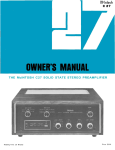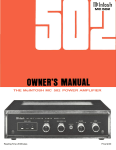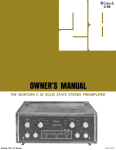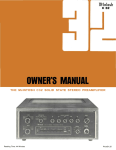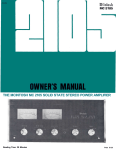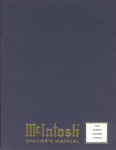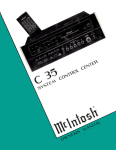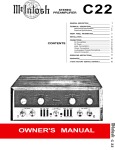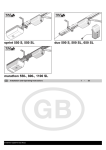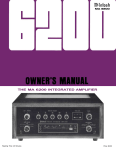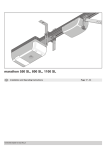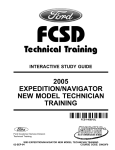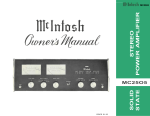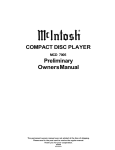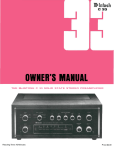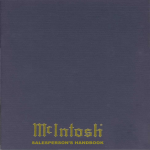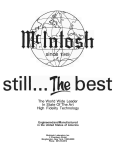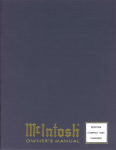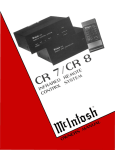Download McIntosh MCD 7007 Operating instructions
Transcript
IMPORTANT SAFETY INSTRUCTIONS THESE INSTRUCTIONS ARE TO PROTECT YOU AND THE MclNTOSH INSTRUMENT. BE SURE TO FAMILIARIZE YOURSELF WITH THEM. 1. Read all instructions - Read the safety and operating instructions before operating the instrument. 2. Retain Instructions - Retain the safety and operating instructions for future reference. 3. Heed warnings - Adhere to warnings and operating instructions. 4. Follow Instructions - Follow all operating and use instructions. WARNING: TO REDUCE RISK OF FIRE OR ELECTRICAL SHOCK, DO NOT EXPOSE THIS INSTRUMENT TO RAIN OR MOISTURE. 5. Power Sources - Connect the power supply only to the type described in the operating instructions or as marked on the unit. 6. Power-Cord Protection - Route power-supply cords so that they are not likely to be walked on or pinched by items placed upon or against them, paying particular attention to cords at plugs, convenience receptacles, and the point where they exit from the instrument. 7. Ventilation - Locate the instrument for proper ventilation. For example, the instrument should not be placed on a bed, sofa, rug, or similar surface that may block ventilation openings; or, placed in a built-in installation, such as a bookcase or cabinet, that may impede the flow of air through the ventilation openings. 8. Heat - Locate the instrument away from heat sources such as radiators, heat registers, stoves, or other appliance (including amplifiers) that produce heat. 9. Wall or Cabinet Mounting - Mount the instrument in a wall or cabinet only as described in the owners manual. 10. Water and Moisture - Do not use the instrument near water - for example, near a bathtub, washbowl, kitchen sink, laundry tub, in a wet basement, or near a swimming pool, etc. 11. Cleaning - Clean the instrument by dusting with a dry cloth. Clean the panel with a cloth moistened with a window cleaner. 12. Object and Liquid Entry - Do not permit objects to fall and liquids to spill into the instrument through enclosure openings. 13. Power Lines - Locate any outdoor antenna away from power lines. 14. Outdoor Antenna Grounding - If an outdoor antenna is connected to the antenna terminal, be sure the antenna system is grounded to provide some protection against voltage surges and built up static charge. In the U.S.A., section 810 of the National Electrical Code, ANSI/NFPA No. 70-1987, provides information on the proper ground for the mast and supporting structure, ground for the lead-in wire to an antenna discharge unit, and size of ground conductors, location of antenna-discharge unit, connection to grounding electrodes, and requirements for the grounding electrode. For ground wire: a) Use No. 10 AWG (5.3 mm2) copper No. 8 AWG (8.4 mm2) aluminum, No. 17 AWG (1.0 mm2) copper-clad steel, bronze wire, or larger as ground wire. b) Secure antenna lead-in and ground wires to house with stand-off insulators spaced from 4 feet (1.22 meters) to 6 feet (1.83 meters) apart. c) Mount antenna discharge unit as closely as possible to where lead-in enters house. d) Use jumper wire not smaller than No. 6 AWG (13.3 mm2) copper or equivalent when separate antenna grounding electrode is used. 15. Nonuse Periods - Unplug the power cord from the AC power outlet when left unused for a long period of time. 16. Damage Requiring Service - Service must be performed by qualified service personnel when: A. The power supply cord or the plug has been damaged; or B. Objects have fallen, or liquid has been spilled into the instrument; or C. The instrument has been exposed to rain; or D. The instrument does not appear to operate normally or exhibits a marked change in performance; or E. The instrument has been dropped, or the enclosure damaged. 17. Servicing - Do not attempt to service beyond that described in the operating instructions. All other service should be referred to qualified service personnel. 18. Grounding or Polarization - Do not defeat the inherent design features of the polarized plug. Non-polarized line cord adaptors will defeat the safety provided by the polarized AC plug. The lightning flash with arrowhead, within an equilateral triangle, is intended to alert the user to the presence of uninsulated "dangerous voltage" within the product's enclosure that may be of sufficient magnitude to constitute a risk of electric shock to persons. 19. CAUTION: TO PREVENT ELECTICAL SHOCK DO NOT USE THIS (POLARIZED) PLUG WITH AN EXTENSION CORD, RECEPTACLE OR OTHER OUTLET UNLESS THE BLADES CAN BE FULLY INSERTED TO PREVENT BLADE EXPOSURE. Note to CATV system installer: This reminder is provided to call the CATV system installer's attention to Article 820-22 of the NEC that provides guidelines for proper grounding and, in particular, specifies that the cable ground shall be connected to the grounding system of the building, as close to the point of cable entry as practical. ATTENTION; POUR PREVENIR LES CHOCS ELECTRIQUES PAS UTILISER CETTE FICHE POLARISEE AVEC UN PROLONGATEUR, UNE PRISE DE COURANT OU UNE AUTRE SORTIE DE COURANT, SAUF SI LES LAMES PEUVENT ETRE INSEREES A FOND SANS EN LAISSER AUCUNE PARTIE A DECOUVERT. The serial number, purchase date, and Mclntosh Laboratory Service Contract number are important to you for possible insurance claim or future service. Record this information here. Serial Number CAUTION RISK OF ELECTRIC SHOCK DO NOT OPEN Purchase Date CAUTION: TO PREVENT THE RISK OF ELECTRIC SHOCK, DO NOT REMOVE COVER (OR BACK). NO USER-SERVICABLE PARTS INSIDE. REFER SERVICING TO QUALIFIED PERSONNEL. The exclamation point within an equilateral triangle is intended to alert the user to the presence of important operating and maintenance (servicing) instructions in the literature accompanying the appliance. Service Contract Number Upon application, Mclntosh Laboratory provides a Service Contract to the original purchaser. Your Mclntosh Authorized Service Agency can expedite repairs when you provide the Service Contract with the instrument for repair. Copyright 1989 © by Mclntosh Laboratory Inc. Contents INTRODUCTION INSTALLATION HOW TO CONNECT FRONT PANEL CONTROLS OPERATION HELPFUL HINTS PERFORMANCE DATA 3 4, 5 6 Your MCD 7007 Compact Disc Player will give you many years of satisfactory performance. If you have any questions, please contact, CUSTOMER SERVICE 7, 8 9, 10, 11, 12, 13 14, 15 16 Mclntosh Laboratory Inc. 2 Chambers Street Binghamton, New York 13903-9990 Phone: 607-723-3512 Take Advantage of 3 Years of Contract Service. . . Fill in the Application NOW. MclNTOSH THREE YEAR SERVICE CONTRACT An application for A THREE YEAR SERVICE CONTRACT is included with this manual. The terms of the contract are: 1. If the instrument covered by this contract becomes defective, Mclntosh will provide all parts, materials, and labor needed to return the measured performance of the instrument to the original performance limits free of any charge. The service contract does not cover any shipping costs to and from the authorized service agency or the factory. 2. Any Mclntosh authorized service agency will repair all Mclntosh instruments at normal service rates. To receive the free service under the terms of the service contract, the service contract certificate must accompany the instrument when taken to the service agency. 3. Always have service done by a Mclntosh authorized service agency. If the instrument is 2 modified or damaged as a result of unauthorized repair the service contract will be cancelled. Damage by improper use or mishandling is not covered by the service contract. 4. The service contract is issued to you as the original purchaser. To protect you from misrepresentation this contract cannot be transferred to a second owner. 5. Units in operation outside the United States and Canada are not covered by the Mclntosh Factory Service Contract, irrespective of the place of purchase. Nor are units acquired outside the USA and Canada, the purchasers of which should consult with their dealer to ascertain what, if any, service contract or warranty may be available locally. The third generation Compact Disc player continues the world-wide Mclntosh reputation for technological advancement as the reason for a new model. Every aspect of performance is improved: focusing and tracking, decoding, error correction, digital filtering, digital to analog conversion (converters are specially selected for matched channel to channel linearity.) The MCD7007 uses a new integral massive cast disc drive platform whose variable reluctance suspension system is adjusted and tuned to reduce or eliminate both high and low frequency resonances, and the impact of vibrations and shock. There is a low mass, low inertia, high compliance single beam laser pen. The laser pen assembly achieves exceptional radial trackability through a sub-miniature, resonance damped, precisely balanced rigid system design. The single-spot laser - which was already recognized for its readout purity - stays even more precisely on track and in focus, and the digital signal that is read out is processed even more truthfully. Even in the face of disc eccentricity and warp and of disc defects or dirt that would interrupt play in the majority of players, the sound of the Mclntosh MCD 7007 Compact Disc player sets superlative standards of purity. The focus and collimator lenses, the receiver and transmitter faces employ flat glass replica technology. • The motorized front-loading tray is a new antijamming design protected from damage by forced closure. If forced, it will close directly to play the disc or to stand by for additional instruction. • The 10 key access pad permits direct access to the track desired, any sequence of selected tracks, preprogramming by track, index time or combination of these: 1. Button programming in any order of up to twenty tracks. 2. Programability directy from a short scan of each track. 3. Three speed search forward or backward with the sound muted only in the high speed mode in either direction. The full 18-bit dynamic range is derived from matched linear input to output dual 16-bit digital to analog converters with 4-times oversampling. A large FIFO memory can adsorb any data stream fluctuations with adaptive error corrections which can handle bursts to 15 audio frames. The single DAC chip - specifically selected for high performance - incorporates separate 16-bit converters for left and right channels. There is no multiplexing, no delay time between channels, and an extra 4 dB of channel separation. Both high-precision servos are integrated to a higher degree than ever, embodying many functions that have to be performed with discreet components in other players. For these functions, there is no wear, no deterioration with time no setting-up adjustment to go wrong. Thus a permanent improvement in readout accuracy is achieved. Enhanced performance Cross Interleave Reed Solomon Code (CIRC) provides maximum error detection and correction. Error correction has soft muting reinforced with enhanced error concealment of up to 8 uncorrectable samples. Volume can be controlled from either the hand held remote or the front panel buttons. With the MCD7007 Mclntosh Compact Disc Player performance moves to a new pinnacle of cutting edge technological achievement and highest quality music reproduction. Even with dirty or damaged discs, even when the player is bumped or knocked, the music retains its surpassing purity. The full integrity of the sound is preserved beginning with the readout from the compact disc through to the gold-plated connectors on the output. Your selection of the MCD7007 will be continously strenghtened by your day to day use of this superb instrument. Happy listening. INTRODUCTION 3 PLAYER LOCATION The MCD 7007 may be installed in a Mclntosh cabinet or custom installed in furniture of your choice. Always provide adequate ventilation. Never place it above heat generating components such as high powered amplifiers. Provide 1½ inches (3 cm) of space above the player to maintain with a cooling air flow. Always use the compact disc player horizontally, out of direct sunlight and away from other heat sources. REMOVE THE TRANSIT SCREWS On the bottom of the player are two screws which lock the player mechanism to protect it during transportation. Remove these screws and keep them in a safe place. If the player is to be transported these screws must be replaced to prevent damage. CUSTOM INSTALLATION The PANLOC system of installing equipment conveniently and securely, is a product of Mclntosh research. The PANLOC buttons on the front panel will lock the unit firmly in place when turned approximately one-quarter turn clockwise. A onequarter counterclockwise turn of the PANLOC buttons unlocks the chassis from its mounting, To install the instrument in a Mclntosh cabinet, follow the instructions that are enclosed with the cabinet. For any other type of installation follow these instructions: 1. Unpack from Carton Open the carton and remove the PANLOC brackets, hardware package, and mounting template. Remove the instrument from its plastic bag and place it upside down on the shipping pallet. Unscrew the four plastic feet from the bottom of the chassis and unscrew and remove the transit screws. When the instrument is transported, damage can occur unless its transit screws are in place. Keep the transit screws in a safe place for use should you transport the unit. 2. Mark the Cabinet Panel Tape the mounting template in position on the cabinet panel where the instrument is to be install- cd. The broken lines that represent the outline of the rectangular cutout also represent the outside dimensions of the chassis. Make sure these lines clear shelves, partitions, or any equipment. With the template in place, first mark the six A and B holes and the four small holes that locate the corners of the cutout. Then, join the four corner markings with pencil lines, using the edge of the template as a straightedge. 3. Drill Holes Use a drill with a 3/16 inch (5 mm) bit held perpendicular to the panel and drill the six A and B holes. Then, using a drill bit slightly larger than the tip of your saw blade, drill one hole at each of two diagonally opposite corners. The holes should barely touch the inside edge of the penciled outline. Before taking the next step, make sure that the six A and B holes have been drilled. 4. Saw the Panel Cutout Saw carefully on the inside of the penciled lines. First make the two long cuts and then the two short cuts. After the rectangular opening has been cut out, use a file to square the corners and smooth any irregularities in the cut edges. 5. Install the Mounting Strips In the hardware package you will find two mounting strips, and two sets of machine screws. For panels that are less than 1/2 inch (12.7 mm) thick, use the 3/4 inch (19.1 mm) screws; for panels that are more than 1/2 inch (12.7 mm) thick, use the 1-1/4 inch (31.8 mm) screws. Starting at the right-hand side of the panel, insert a screw of the proper length into the center hole in the panel, marked B on the template. On the back of the panel, align a mounting strip with the holes in the panel and tighten the screw until the screwhead is pulled into the wood. 4 INSTALLATION Repeat this procedure to attach the mounting strip to the (eft side of the panel. 6. Attach the PANLOC Brackets Using two screws of the proper length in the A holes on each side, attach the PANLOC brackets to the cabinet panel; the short flange is mounted against the front (face) of the cabinet panel. The screws pass through the PANLOC bracket flange, the cabinet panel, and then through the mounting strips previously mounted. 7. Install the Instrument Guide the AC power cord through the panel opening to the back of the cabinet; then, slide the instrument into the opening carefully so that the rails on the bottom of each side of the chassis engage the tracks on the mounting brackets. Continue to slide the instrument into the cabinet until the front panel is flush with the cabinet panel. Turn the PANLOC buttons at the lower left and right corners of the instrument panel clockwise to lock the unit firmly in the cabinet. Turn the PANLOC buttons counterclockwise to unlock the instrument. It can then slide outward to permit the removal of the instrument from the cabinet. INSTALLATION 5 The back cover of this manual folds out to show photographs of the front and rear panels of the MCD 7007. Fold it out to assist you in identifying and locating the connections. The letters refer to the paragraphs that follow. The back panel of the MCD 7007 has connectors labeled FIXED OUTPUT, VARIABLE OUTPUT, REMOTE, a port marked DIGITAL OUTPUT and the AC power cord. The VARIABLE OUTPUT is adjusted by the front panel VOLUME buttons while the FIXED OUTPUT is unaffected by these controls. Use shielded cables to connect the output signal to a preamplifier or power amplifier. To minimize the possibility of hum, the shielded cables should be of parallel construction or loosely twisted together and located away from the speaker connecting cables and AC power cords. Be certain to use good quality shielded cables for all interconnections. Your dealer can advise you on the kind and length of cables that will best suit your installation. A. FIXED OUTPUT The FIXED OUTPUT jacks are used to feed program to a stereo preamplifier or other equipment with its own volume control. B. VARIABLE OUTPUT Use the VARIABLE OUTPUT jacks to connect to a power amplifier or a tape recorder where control of the volume at the player is desired. There is no difference in the signal quality at either pair of output jacks. Both pairs of output jacks may be used simultaneously. Connect the audio output of the player to the "CD", "AUX", or other high level input on the preamplifier. Do not connect to the "PHONO" input. Connect the Right player output to the right preamplifier input and the Left player output to the left preamplifier input. E. AC POWER Plug the AC power cord into a 120 volt 50/60 Hz receptical. The plug blades are polarized so be certain the plug is fully inserted in the outlet to prevent blade exposure. CAUTION: TO PREVENT ELECTRIC SHOCK, DO NOT USE THE (POLARIZED) PLUG ON THIS UNIT WITH AN EXTENSION CORD, RECEPTACLE, OR OTHER OUTLET UNLESS THE BLADES CAN BE FULLY INSERTED TO PREVENT BLADE EXPOSURE. INSERTING THE BATTERIES IN THE REMOTE CONTROL Your Mclntosh Compact Disc Player includes an infrared Remote Controller. In your hand you have the ability to control normal operating functions of the disc player. The controller runs on two AA, 1.5 Volt batteries. Slide open the cover on the back of the remote controller and insert the batteries as shown in the diagram in the battery compartment, then slide the cover closed again. Battery life is normally about one year. Remove the batteries as soon as they are dead to prevent damage by possible battery leakage. The batteries should be removed, also if the remote controller is not used for a long time. C. REMOTE The REMOTE control connector is designed for use with the Mclntosh multi-area infrared remote control systems. With these systems, you can, from a hand-held remote control, operate the disc player and the entire system from various listening areas. D. DIGITAL OUTPUT The digital data stream is available from this port for use in systems that can accept digital data directly. 6 HOW TO CONNECT Fold out this manual's back cover to assist you in locating the controls. The numbers on the photographs refer to the paragraphs that follow, The glass upper half of the MCD 7007 front panel contains the CD drawer, the IR REMOTE SENSOR, the REMOTE response LED, the DAMAGED DISC indicator and the message center. The message center displays the current status of the mode of operation, disc time, the CD functions in use and the horizontally displayed volume level indicator. The black anodized lower half of the front panel contains the buttons to program the player, activate the various player functions, and to control the VOLUME. A headphone jack with its own volume control and PANLOC loading buttons are also on this panel. Before operating your Compact Disc player, familiarize yourself with the controls and what they do. 1. POWER Touch to switch the AC power to the player on or off. 2. LOAD Touch to open or close the disc drawer. An LED above the LOAD button illuminates when the drawer is operating. 3. PLAY Touch to close the disc drawer and to start play. Touch to return to the beginning of the track being played. 4. VOLUME Volume may be adjusted by using the VOLUME or on the front panel or on the remote controller. The volume is adjusted by an electronically switched, precision, ladder attenuator. The Mclntosh electronic precision ladder attenuator adjusts volume using C2 MOS transistor switches to select the right combinations of deposits of resistive material for the volume programmed. The entire range of volume adjustment is 66 dB in 2 dB increments. Left and right tracking is controlled to a fraction of a dB. Because there aren't any moving parts, the volume adjustment cannot generate noise or misalignment. 5. MESSAGE CENTER The message center presents information about the number of tracks on the disc, the playing time, the progress of play, the particular functions of the player, and signals errors during operation or programming. (See also: MESSAGE CENTER pg. 10). 6.-7. REV AND FF Touch and hold to provide quick access to a particular passage. 8. REPEAT Touch to repeat the disc or a program. 9. PAUSE Touch to interrupt and hold play. Touch again to continue the playback. 10. STOP Touch to stop play during playback and to delete a program. 11. TIME Displays, in the message center, the eLAPsed playing time or the time REMaining on the disc. 12. BACK TRACK Touch, during play to return to the previous track. 13. NEXT TRACK Touch, during play to move to the next track. 14. PHONES Jack provided for private headphone listening. 15. LEVEL Adjust the loudness in the headphones. 16. SCAN Touch to close the disc drawer and/or to automatically play the beginning 10 seconds of each track on the disc. 17. Touch at beginning and end when a section of a Compact Disc is to be played repetitively. 18. REVIEW Once a disc has been programmed, the program can be displayed in the message center when the REVIEW button is touched. If there isn't a program entered, ERROR will illuminate. 19. SELECT Each time the SELECT button is touched when programming, the programming mode is advanced through TRACK, to INDEX, to MINutes and to SEConds. 20. 0 thru 9 Buttons permit direct access programming. The MCD 7007 can be programmed by TRACK, INDEX, MINutes and SEConds or combinations of these. 21. STORE Each detail of the programming will be inserted in the memory by a touch on the STORE button. FRONT PANEL 7 22. CLEAR When touched will erase from the memory an entry error or break out of an continuous loop. 23. REMOTE SENSOR Receives the coded infrared signals from the remote control. 24. DAMAGED DISC/MUTE Lights when a playing disc is damaged or has errors which are not correctable by electronic interpolation. It also lights when the player is muted by more seriously damaged discs, or when PAUSE, STOP, REV, FF , BACK TRACK and NEXT TRACK are used and when a disc is not playing. 25. REMOTE This LED lights when the IR Remote Control is used to operate the functions of the MCD 7007. 26. PANLOC Turn to secure or release the player from the cabinet. 8 FRONT PANEL POWER-1. Touch the POWER button to turn the player on. The TRACK, INDEX, TIME, eLAPsed time and VOLUME indicators will light up in the display area. Touch POWER again and the player is turned off and the indicators turn off. LOAD-2. Touch the LOAD button and the LED above this button will illuminate, then after 1 second the drawer will open. If the drawer is obstructed, it will not continue to open. Should this happen remove the obstruction, touch LOAD twice in succession to bring the drawer fully out. Hold the disc at the rim and place it, label side up, in the disc drawer. Close the drawer by touching PLAY, SCAN or LOAD. Use PLAY if you want to play the complete disc, SCAN if you first want to preview each track on the disc or store tracks from it, and LOAD if you want to program the disc. In each case, the drawer slides in when the button is touched. If the drawer is obstructed as it closes, the drawer will come out again after about 3 seconds. Using LOAD to close the drawer, permits the laser pen to read the contents list and then display the number of tracks and the total time encoded on the disc. After reading the contents list, the MCD 7007 switches to stand-by mode ready for further instructions. The DAMAGED DISC/MUTE indicator remains lighted until play begins. If the light remains on and the disc refuses to play, make sure that the disc is properly in the drawer and label side is up. To close the drawer when it is empty touch the LOAD button. The DAMAGED DISC/MUTE sign will light. To prevent the entry of dust, do not leave the drawer open. Opening the drawer during play, will stop the disc. PLAY-3. To play the complete disc, close the drawer by touching PLAY. After the contents list on the disc has been read, the number of tracks on the disc will be displayed on the track indicator. When play begins, elapse playing time is displayed and the eLAPsed indicator lights. To go back to the beginning of a track while it is playing, touch PLAY. The track is then repeated from the beginning. When all the tracks have been played, the track indicator, the total elapsed time and the DAMAGED DISC/MUTE indicator will light. All indicators except the volume display turn off. VOLUME-4. Volume may be adjusted by using the VOLUME or VOLUME on the front panel or on the remote control. Adjustment of the volume is performed by an electronically switched precision ladder attenuator. The Mclntosh electronic precision ladder attenuator adjusts volume by C2 MOS transistor switches that select the right combinations of highly accurate deposits of resistive material for the volume programmed. The entire range of volume adjustment is 66 dB in 2 dB increments. Left and right tracking is controlled to a fraction of a dB. Because there aren't any moving parts, the volume adjustment cannot generate noise or misalignment. The VOLUME indicator in the message center is a 10 segment display. As volume is increased, more segments are lighted to indicate relative volume. SCAN-16. The first 10 seconds of each track will be played when the SCAN button is used to initiate play. As each track is previewed the SCAN indicator, the TRACK number and the eLAPsed TIME is displayed. When the tracks have been previewed, the SCAN indicator turns off, the laser pick-up returns to the beginning of the first track. The total number of tracks and the total time will be displayed in the message center. If, before you have previewed all tracks, you decide to listen to all of the remaining tracks on the disc, touch PLAY. The SCAN indicator will go off and the remaining tracks will play in their entirety, beginning with the track indicated in the message center. Any track can be entered in the memory for later playing while using SCAN. To enter a track, touch STORE while the track is playing and the TRACK will be inserted in the memory. The player will preview the next track and the indicator for that track will be displayed. When all tracks have been previewed, SCAN will go off. To listen to the stored program, touch PLAY And the disc will play the stored tracks in the sequence selected. OPERATION 9 MESSAGE CENTER DISPLAY-5. Disc symbol flashes during loading and starting Track or index symbols flash during programming. Minutes or Seconds symbols flash during programming. Play is in continuous loop between selected points A (start) and B (end). Flashes during programming. Indicates REMaining Total Time or eLAPsed Track Time. The display in the message center presents many different types of information. As soon as the POWER button is touched to turn the player on, the message center shows a series of zeros in TRACK, INDEX and TIME. The eLAPsed time indicator and the VOLUME bar are also lighted. The LOAD button opens and closes the disc drawer. Once opened, place a disc in the drawer label side up. When the LOAD button is used to close the drawer, the laser pen will read the contents of the disc from the encoded data. The message center information will change to show the number of tracks and the total recorded time on the disc. The player then goes to 'stand-by' mode until further instructed. The drawer can be closed and play begun by touching SCAN or PLAY. The message center display will change to show the track being played and the eLAPsed time. TRACK Displays the total number of tracks on the disc when activated by the LOAD button. When in other modes of operation, the track being played is displayed. When programming, the word TRACK under the digits will flash to indicate that TRACK data can be entered in the memory. INDEX When a disc has been encoded with index data the INDEX area will display the index being played. When programming, the word INDEX under the digits will flash to indicate that INDEX data can be entered in the memory. 10 OPERATION SCAN function is active. PAUSE function is active. REPEAT function is active. Indicates Relative volume level Indicates program has been stored. Encoded program is being displayed. MINutes/SEConds Displays the total disc time when activated by the LOAD button. When in other modes of operation, the eLAPsed time on the track being played will show. When programming, the MINutes or SEConds will flash to indicate that data can be entered in the memory. eLAPsed/REMainder This button changes the display in MINutes and SEConds from elapsed (LAP) time on this track to the remaining (REM) time on the disc. A second touch returns the display to eLAPsed time. DISC (flashing red) When flashing indicates the laser pen has moved to the contents area of the disc and is reading the data into the digital memory for display. Should the drawer not contain a disc the DISC indicator will flash and the ERROR indicator light for a few seconds then both will turn off. ERROR Should an inaccurate instruction be given the ERROR indicator will light briefly. New instructions must be instituted to put the player in action. When illuminated, the player has been programmed to play and repeat a portion of the disc programmed by the button. A flashing indicator reminds you that the programming is not completed. When completed both the and the PROGRAM indicators are lighted. PROGRAM Illuminates to show that the sequence of playback is controlled by the preselected program or the continuous loop. SCAN If the SCAN button was used to activate the player the SCAN indicator will light and remain lighted until all tracks have been scanned. REVIEW When the REVIEW button is activated the indicator is lighted and the program is displayed in sequence on the appropriate TRACK, INDEX, and MIN/SEC indicators. REPEAT The REPEAT indicator will light to show that the disc or program will be replayed upon completion. PAUSE When the PAUSE button is pressed, the laser pen stops instantly while the disc continues to rotate. The player remains ready to play at the precise point that the PAUSE was activated. Very useful in tape recording, answering the phone, etc. VOLUME A 10 segment horizontal bar displays the relative loudness of the volume. As volume is increased more segments are illuminated. REV - FF -6-7 During play, you can quickly locate a particular music passage in a track by holding in REV or FF . While you hold REV, the laser pick-up moves toward the beginning of the track or disc; while you hold FF , the laser pick-up moves toward the end of the track or disc. By using REV and FF alternately, you can find any part of any passage. After release, play restarts at once. During REV and FF , the laser pick-up moves at three successive speeds: for the first few seconds relatively slowly, for the next few seconds faster, and after approximately 10 seconds, at maximum speed. During the two slower speeds, the program material can be heard at reduced volume. At high speed the sound is muted. If you continue to hold down the FF or REV the numbers of the time display run on at a corresponding rate. When nearing the desired passage, release momentarily to go back to the lowest speed. If, by holding in REV, the laser pick-up moves to the run-in of the first track, the ERROR indication lights and the laser pick-up stops at the beginning of the track. The disc continues to spin, however, so that play will resume upon release of the button. If, by holding in FF , the laser pick-up moves to the run-out of the last track, the ERROR indication lights, and the laser pick-up moves back over the disc about 20 seconds and remains at that point until FF is released. REPEAT-8. To hear the whole disc or a program again, touch REPEAT before the disc ends. The REPEAT sign will light, and the disc will repeat continuously until you touch REPEAT again. The REPEAT sign will go off and the disc will play to the end and stop. Touch LOAD or STOP, the REPEAT sign will go off and play will stop at once. PAUSE-9, The laser pick-up can be stopped exactly at the start of a track or a passage by touching PAUSE and the PAUSE sign will light. To start play, touch PAUSE again. The PAUSE sign will go off. To hold play at the beginning of a track or a passage, or to interrupt the program, touch PAUSE. To begin play again, touch PAUSE. It will resume at the exact point it was interrupted. The PAUSE sign will go off. STOP-10. To stop play before the end of the disc, press STOP. TIME-11. Anytime the disc is playing the message center will display the eLAPsed time of the track playing. Touch the TIME button to display the remaining (REM) time on the disc. Touch again to return to eLAPsed time. BACK TRACK-12. To play an earlier track on the disc, touch BACK TRACK. Each touch moves the laser pen and the display on the track indicator back one track. Play is temporarily interrupted while the laser pick-up moves. If you touch BACK TRACK during play of the first track, the ERROR sign will light, as a reminder that there is no previous track. Play of the first track continues. NEXT TRACK-13 To play a later track on the disc, touch NEXT TRACK. Each touch moves the laser pen and the display on the track indicator forward one track. Play is temporarily interrupted while the laser pick-up moves. OPERATION 11 If you touch NEXT TRACK during play of the last track, the ERROR sign will light as a reminder that there is no next track. Play of the last track continues. LISTENING WITH HEADPHONES-14. With headphones connected to the PHONES jack, you can listen to discs without having to use an amplifier. Adjust the sound level with the LEVEL control. The headphones must have a 0.25 inch (6.3 mm) jack plug and an impedance between 8 and 1000 ohms. -17. Should you wish to hear a portion of the disc repeatedly, touch the button at the start of the section you wish repeated. Allow the disc to play until the end of the repeat section and touch again. The program between the two points will be repeated until CLEAR, STOP or LOAD are touched. 0 thru 9-20. These buttons provide a total sequence of direct access input of 20 tracks selected from tracks 1 through 99 for storage in the memory of the MCD 7007; any sequence of TRACKS, of INDEX numbers or of time. To start playing a disc other than at the beginning, touch the track number to be played on the 0-9 key pad followed by the PLAY button. The selected track number will be displayed in the message center and the track indicator will flash. The disc will begin at the track selected and play the remaining tracks on the disc. If you have selected a track which does not exist ERROR will appear briefly on the display. STORE-21 From the program list provided with the compact disc, decide on the tracks you want to include in the program. For each track, touch the appropriate number buttons and then the STORE button to insert the disc track in the program memory. Tracks may be stored in the sequence on the disc when in the SCAN mode. While listening to the preview of a track in SCAN, touch the STORE button to store that track for later playback. The PROGRAM indicator will light and the TRACK display will immediately move to the next track. The total memory will store up to 20 tracks in any order, these tracks may be selected from any number of tracks up to 99. They do not need to be sequential. 12 OPERATION Your program can contain any combination of: • TRACK • TRACK and INDEX • TRACK and TIME • TRACK, INDEX and TIME However, you are limited to 20 units of memory. Each TRACK number takes up 1 unit each, TRACK and INDEX number takes up 2 units and each TRACK, INDEX and TIME takes up 5 units. If there is an attempt to enter more than 20 units, ERROR appears on the display. To enter a program, insert a disc and use LOAD to close the disc tray. If you make a mistake or wish to change your program at any time, touch the CLEAR button before touching the STORE button to erase the memory, then begin program entry again. Follow this example of a program from a disc containing 32 tracks. The program sequency desired from the disc is: 3, 10, 31, 18, 2, etc. using the numeric key pad, touch 3 then STORE, the TRACK indicator will show 1 to indicate that block has been used. Touch 1 then 0 then STORE, touch 3 then 1 then STORE, touch 1 then 8 then STORE, touch 2 then STORE, etc. until your entire program has been entered into the memory. If ERROR appears on the display make sure the selected track number exists or whether all 20 memory blocks are full. Touch PLAY to listen to the entire program as entered. The program can be played again, before touching STOP or LOAD by touching the PLAY button. The program remains in the memory until the STOP or LOAD button is touched. CLEAR-22 Touch CLEAR to remove an incorrect selection from the memory. To erase any single TRACK entry from the program, touch the REVIEW button to exhibit in the message center the program entered. Each entry will be briefly displayed. As soon as the entry to be deleted is seen, touch the CLEAR button which will erase that entry from the memory. REVIEW-18 The program entered can be reviewed by touching the REVIEW button. The TRACK numbers in the message center will be illuminated in the sequence entered in the memory. SELECT-19 Touch the SELECT button to change the input to memory from TRACK to INDEX or to TIME. Touch SELECT once and the TRACK indicator will flash on and off which indicates the numeric key pad TRACK selection is connected to the memory input. Touch SELECT twice which causes the INDEX indicator to flash and which connects the numeric key pad INDEX selection to the memory input. Touch SELECT three times and the MINutes flash for programming by any given minute in a track. When SELECT is touched four times programming can be started on the second. Suppose you wish to hear track 7 at 4 minutes and 18 seconds. Touch in sequence SELECT, the TRACK indicator will flash, touch 7, then touch SELECT two times, the MINutes indicator will flash, touch 4, then touch SELECT once, the SEConds indicator will flash, touch 1, then 8, and PLAY. The disc will start track 7 at 4 minutes and 18 seconds and play to completion. Programming in progressive numeric sequence by TRACK is easily done when the SCAN button is used to start the play sequence. As a TRACK number is displayed in the message center a touch on the STORE button will insert, the displayed track into the memory. The display will immediately switch to the next track. Up to 20 TRACKS can be stored. To program TRACKs in random sequence use the 0-9 keypad. Twenty tracks in any order from 1 to 99 can be inserted in the memory. When the 20 tracks have been programmed filling all units of memory, further entries will not be stored and the red ERROR indicator will light for a few seconds. Twenty units of memory provide programming by direct TRACK input, TRACK and INDEX TRACK AND TIME, TRACK, INDEX and TIME and any combinations of the four, the STORE and the SELECT buttons. Each TRACK entered used one unit of memory; each TRACK and INDEX, uses two units of memory and each TRACK and TIME entry, five units of memory. Up to 20 TRACKS only may be programmed, up to 10 TRACKS with INDEX or 4 TRACK and TIME entries. To arrange TRACK in the sequence of your choice, use the 0-9 keypad and STORE button. When the disc drawer has been closed by using the LOAD button, the message center will display the number of tracks and the total recorded time on the disc. On the 0-9 keypad touch the track number and then touch STORE to program the sequence you desire. The memory will be updated and the display will show the number of entries made and the total time of these entries and the PROGRAM will light. To program by TRACK and INDEX, the 0-9 keypad, the SELECT and STORE buttons are used. First, close the disc drawer using the LOAD button. Enter the desired track by using the keypad. Upon entering the track, the word TRACK, under the digits, will flash. Move the flashing symbol to the INDEX space by touching SELECT. When the word INDEX begins to flash enter the desired INDEX number by using the keypad, followed by touching the STORE button. The PROGRAM block will light in the message center and TRACK will switch to show the number of entries made to the memory. The TIME indicator will show only zeros. DISC MAINTENANCE For the best results, apply the same care in storing and handling the Compact Disc as with conventional records, Even though the music track in the disc is covered by a protective layer, treat the disc carefully. Always pick up discs by the edge, and put them back in their protective cases immediately after use. Wipe fingerprints, dust or dirt off with a soft, lint-free cloth. Wipe in a straight line from center to edge. You can breathe on the disc first if necessary. Cleaning agents for conventional records, detergent or abrasive cleaners must never be used. Never write on the label side of the disc. Writing will emboss the disc and destroy the digital data. If you follow these suggestions, the Compact disc will provide a lifetime of pure listening enjoyment. PLAYER MAINTENANCE The player mechanism has self-lubricating bearings, and must mot be oiled or greased. The disc drawer should be kept free of dust. OPERATION 13 The greatest care has been taken in the manufacture of your Mclntosh Compact Disc player. In case of operational difficulties and to save you unnecessary service calls, here is a list of their possible causes and suggested solutions. Should you need further guidance, contact your dealer. He will be able to advise you. Under no circumstances should you open up the player. To do so can void the service contract. 1. After touching POWER, the track indicator does not light. • Touch the POWER button again. POWER was not pressed in far enough. They require only .007" movement to engage. • The player is not properly plugged into the 120V AC supply. • There is no 120V AC supply. Plug in another electrical appliance and see if it functions in the same outlet. 2. After touching LOAD, the disc drawer does not slide out. • The player is not switched on and the message center data will not light. • The microprocessor has not received the command correctly. Touch STOP and then touch LOAD again to see if the drawer opens. • The drawer drive is not functioning. You cannot correct this yourself. If a disc is in position, remove it by pulling the drawer open carefully, then push the drawer in to close it again. 3. After touching LOAD, PLAY or SCAN, the disc drawer does not slide in. • The 120 VAC supply has been disconnected and the track indicator will not light. • The microprocessor has not received the correct command. Touch STOP and then touch LOAD, PLAY or SCAN again to see if the drawer closes. • The drawer drive is not functioning. You cannot correct this yourself. If a disc is in position, remove it, than push the drawer in carefully to close it. 4. After closing the drawer the Message Center Data shows the 'OoOoo' and the DISC and ERROR light and nothing further happens. clean disc. • The disc is defective. See if another disc clears the problem. • There is an unwanted object in the disc drawer, such as a piece of paper or a remnant of the packaging. • The player is not horizontal. 5. The disc is being played as shown by the time elapsed indicator, but there isn't any sound. • The microprocessor has not received the correct command. Check if touching STOP and then restarting clears the problem. • The preamplifier is not switched on. • The preamplifier source selector is not turned to the input to which the player is connected. • The preamplifier, amplifier or the loudspeakers connected to it are not working. Check with another sound source. • The connection between the player and the preamplifier is broken. • The input to which the player is connected is defective. Check by connecting the player to another input. • Volume control is turned down. • Player in PAUSE mode 6. The sound is poor or distorted or you can hear only one channel. • The transport screws have not been removed. • The disc is dirty or badly scratched. Clean the disc or use another clean, scratch-free disc. • There is an unwanted object in the disc drawer, such as a piece of paper or a remnant of packaging. • The preamplifier or the loudspeakers connected to it are not working properly. Check with another sound source. • The player is connected to the PHONO input not the CD, AUX, or other high level input of the preamplifier. • One of the plugs of the connecting cable is either not connected or not properly connected. • The player is not horizontal. • The transport screws have not been removed. • The disc is not inserted label up or there isn't a disc in the drawer and you have missed the ERROR DISC sign. • The disc is dirty. Clean the disc, or use another, 14 HELPFUL HINTS 7. Programming is not working properly. • The disc is dirty or badly scratched. Clean the disc or try programming with a scratch-fee disc. • The microprocessor has not processed the commands properly. Clear the program by touching STOP and store it again; re-start play. • All 20 memory places are already programmed and you have missed the ERROR sign that shows this. Check by touching the REVIEW button to ensure the program memory. 8. The following problems can be caused by the same circumstances: Playback does not begin with the first track on the disc or of the program, but with another track. Playback stops before the end of the disc or the program. • The microprocessor has not processed the command correctly. Touch STOP and re-start to clear the memory. • The disc is dirty or badly scratched. Clean the disc or use another, clean, scratch-free disc. • The disc is defective. Try another disc. • There is an unwanted object in the disc drawer such as a piece of paper or a remnant of packaging. • The player is not horizontal. 9. The player does not react to commands from the remote control. • The batteries are low and the distance to the player is too great. Aim in the direction of the player. • Direct sunlight or high intensity room light shining on the remote sensor. Shade the sensor from sunlight. • The batteries are dead. HELPFUL HINTS 15 TYPICAL AUDIO PERFORMANCE NUMBER OF CHANNELS 2, left and right FREQUENCY RESPONSE 20-20,000 Hz, +0, -0.3 dB DYNAMIC RANGE 96 dB (114 dB EIA) SIGNAL-TO-NOISE RATIO 107 dB (A) CHANNEL SEPARATION 102 dB (at 1000 Hz) TOTAL HARMONIC DISTORTION 0.0012% (at 1000 Hz) WOW AND FLUTTER Quartz crystal precision SAMPLING RATE 176.4 kHz D/A CONVERSION Quadruple oversampling (176.4 kHz) with digital filter and two 16 bit D/A converters ERROR CORRECTION SYSTEM Cross Interleave Reed Solomon Code (CIRC) AUDIO OUTPUT LEVEL 2.5V IMPEDANCE HEADPHONES 8-1000 ohms DIGITAL OUTPUT Output for digital signal processing OPTICAL READOUT SYSTEM LASER Semi-conductor AIGaAs WAVE LENGTH 780 nm SIGNAL FORMAT SAMPLING FREQUENCY 44.1 kHz QUANTIZATION 16 bit linear/channel DISC DIAMETER 120 mm THICKNESS 1.2 mm ROTATION (seen from reading side) Counter-clockwise SCANNING VELOCITY 1.2-1.4 m/s ROTATION SPEED 500-200 rpm PLAYING TIME (maximum) 74 minutes (stereo) TRACK PITCH 1.6 um MATERIAL Plastic BUTTONS Power Scan* A B* Review Select Store* Clear 0 thru 9 Volume* Volume * Load Play* Rev* FF Repeat* Pause* Stop* Time Back Track* Next Track* *also provided on HR7007 Remote Control Transmitter. CONTROLS Level for Headphones Headphone Jack SPECIAL FEATURE Damaged Disc/Mute Error Correction Indicator POWER SUPPLY 120V, 50/60 Hz, 30 watts MECHANICAL INFORMATION SIZE Front panel measures 16 1/8 inches wide (41 cm) by 5 7/16 inches high (13.8 cm) by 13 inches deep (33 cm), including connectors. Knob clearance required is 3/4 inches (1.9 cm) in front of mounting panel. FINISH Front panel is glass with gold/teal nomenclature illumination and anodized gold and black aluminum. Chassis is black. MOUNTING Exclusive Mclntosh developed professional PANLOC. WEIGHT 18 pounds (8.2 kg) net, 30 pounds (13.6 kg) in shipping carton. 16 PERFORMANCE DATA THE LOCATION OF CONTROLS AND BUTTONS The numbers and letters correspond to the paragraphs on pages 6 thru 13




















